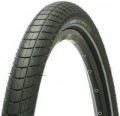EPI (TPI)
The carcass density of the tyre in threads per inch (Ends Per Inch or Threads Per Inch).
The material of a bicycle tyre is composite in composition, it includes a beading cable (see below), a frame (cord) made of synthetic fabric, and rubber itself (compound). The density of the frame determines primarily the softness of the product; dynamics, rolling, cross-country ability and a tendency to crush when hitting obstacles and other heavy loads depend on this. So, a soft cord is better suited for driving over rough terrain, including on difficult surfaces like sand or gravel: it provides a larger contact patch, crumple well on small bumps and allows you not to lose speed when hitting a small obstacle like a pit, tree root, etc. Yes, and it shakes on such tyres less than on hard ones. On the other hand, they hold speed and roll worse, and also have an increased likelihood of punctures in certain situations: for example, a sharp stone can dent the tyre to the very rim and pierce the chamber.
Hard tyres, in turn, are distinguished by good dynamics: it is easier for them to pick up speed and maintain it. Yes, and when hitting the same sharp stone, the probability of a puncture will be much lower. On the other hand, the slightest obstacle on the road when driving on such tyres will lead to a noticeable loss of speed, and on uneven surfaces the bike will be subject to strong shaking. In addition, from a certain value (120 EPI and above), an increase in the dens...ity of the carcass does not increase, but a decrease in reliability: a high density of threads leads to a decrease in their thickness and, accordingly, strength.
Also recall that the actual stiffness of the wheel will depend not only on the carcass, but also on the pressure in the tyre. So in some situations, the features of the frame can be completely compensated for by selecting the appropriate pressure.
If we talk about specific numbers, then tyres with a cord density of up to 60 EPI (TPI) can be classified as soft, up to 90 TPI — as medium, up to 120 — as hard, and a value of more than 120 EPI (TPI) corresponds to high rigidity. With the above in mind, soft tyres are better suited for rough terrain and stunt riding, while hard tyres are better for high-speed driving on flat roads. More detailed recommendations on this matter can be found in special sources.
Weight
The total weight of the tyre.
This indicator affects the overall weight of the bike, but this influence is so insignificant that in most cases it can be neglected — especially since the difference between tyres similar in size and use can be some tens of grams, or even grams. In fact, paying attention to weight makes sense mainly when used in professional racing, where the struggle sometimes goes for tenths of a second — and, accordingly, every extra gram can be decisive. If tyres are bought for simpler use — for example, amateur "rides" on roads or even cross-country — this parameter can not be given much attention.

